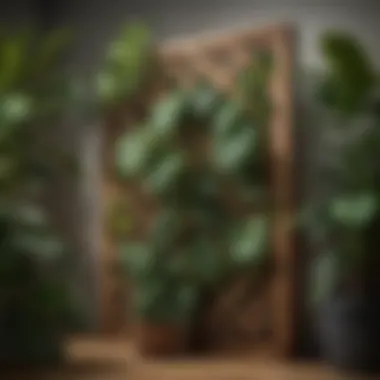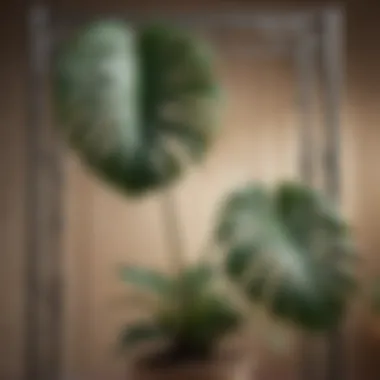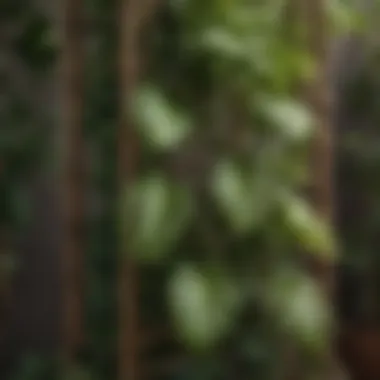Optimal Trellis Solutions for Thriving Monstera Plants


Intro
Monstera plants are increasingly becoming a popular choice for indoor gardening enthusiasts and decorators alike. These tropical plants, native to Central America, are known for their striking leaves and robust growth. To ensure that monstera plants thrive, it is crucial to provide them with appropriate support, which will be discussed in this article.
Choosing the right trellis can greatly affect the health and aesthetic appeal of your monstera. A well-chosen trellis not only supports vertical growth but also enhances the overall visual presentation of the plant. This article will serve as a detailed guide, examining various trellis solutions tailored for monstera plants, analyzing materials and designs along with their functionalities.
As we explore trellis options, the specific needs and growth habits of monstera plants will be highlighted, aiding plant enthusiasts in making informed decisions. The goal is to help you create an environment where your monstera can flourish.
Overview of Monstera Plants
Common Name and Scientific Classification
Monstera is a genus of flowering plants in the family Araceae. The most renowned species is Monstera deliciosa, commonly referred to as the Swiss cheese plant due to its unique leaf perforations.
Physical Characteristics
These plants are characterized by large, glossy, heart-shaped leaves that can grow up to three feet in length. Over time, monstera plants develop splits and holes, a process known as fenestration. Sturdy aerial roots also emerge, allowing the plant to cling to nearby structures in its natural habitat.
Habitat and Distribution
Monstera is indigenous to tropical rainforests from southern Mexico to Panama. In the wild, they typically grow as climbing vines, utilizing trees and other foliage for support. Understanding their natural growth pattern can assist gardeners in replicating the correct conditions for these plants.
Importance of Trellises
Using trellises serves multiple purposes in the care of monstera plants. A trellis offers physical support for climbing and growing vines, promoting upright growth that enhances the plant's overall health. Additionally, an appropriate trellis contributes to better air circulation around the plant, reducing the risk of pests and disease. Since monstera plants can reach significant heights, a well-designed trellis is vital in maximizing vertical space, especially in indoor environments.
Trellis Material Options
When selecting a trellis for monstera plants, various materials can be considered, each offering unique benefits:
- Wood: A classic choice, wooden trellises provide stability and a rustic look. Cedar or bamboo is preferable due to their natural resistance to moisture.
- Metal: Metal trellises are strong and can support heavy plants. They are durable but may require a coat of paint to prevent rust.
- Plastic: Lightweight and easy to handle, plastic trellises are often cost-effective, though they may not be as aesthetically pleasing as other materials.
- Natural Fiber: Materials like jute or sisal offer a more organic choice and can blend well with houseplant decor.
Choosing the right material is important, as it can influence the longevity and effectiveness of the trellis.
Trellis Designs
The design of the trellis also plays a key role in supporting monstera plants:
- Vertical Trellis: Best suited for climbing, these trellises facilitate vertical growth and can be incorporated into pots for maximum effect.
- A-Frame: This design provides ample support and is visually appealing, making it ideal for decorative purposes.
- Wall Mounted: Perfect for small spaces, wall-mounted trellises utilize vertical wall space and can be backed by a decorative surface or art.
Each design brings its own set of advantages and aesthetics. Careful consideration of space and style will enhance your indoor plant experience.
Understanding Monstera Plants
Monstera plants, also known as Monstera deliciosa, are a unique breed of tropical foliage that not only captivates plant enthusiasts but also serves as a striking addition to interior spaces. Understanding these plants is crucial for anyone who wishes to provide optimal care and support. The knowledge of their origins, growth patterns, and specific requirements allows for effective trellis selection and enhances the overall vitality of the plant.
Originating from Tropical Rainforests
Monstera plants originate from the lush tropical rainforests of Central and South America. In their natural habitat, they thrive among trees, often climbing and spreading to seek sunlight while climbing upwards. This adaptation means that, in cultivation, they require support structures like trellises to mimic their natural growth and maximize exposure to light.


The jungle-like environment provides them with high humidity and filtered light, contributing to their impressive growth. Therefore, when keeping a monstera in a domestic setting, replicating these conditions is paramount. Understanding their natural setting informs how to create an inviting environment at home.
Growth Patterns and Requirements
Monstera plants exhibit a distinctive growth pattern characterized by dramatic leaves that can reach up to three feet in length. Their leaves are initially heart-shaped, become more lobed with age, which allows them to adapt better to strong light and wind in their native habitat.
In terms of requirements, monstera plants need a balanced watering schedule. Overwatering can lead to root rot. This is where supportive structures come into play; a trellis can help keep the plant stable, reducing the risk of physical damage from wind or accidental bumps.
Light is another essential element. Monstera prefers indirect sunlight. Too much direct light can scorch the leaves, whereas too little can hinder their growth. Proper positioning of the trellis ensures that the plant can climb to optimal light levels, which promotes healthy growth.
Ultimately, understanding monstera plants provides a solid foundation for selecting the right trellis solution. By catering to their unique needs, plant owners can witness vibrant growth and create a thriving indoor ecosystem.
The Importance of Support Structures
Support structures play a crucial role in the healthy growth of monstera plants. As these plants are naturally climbing species, they require external support to mimic their natural habitat found in tropical rainforests. Understanding the significance of trellises provides insights into why they're a necessity for monstera cultivation.
Facilitating Healthy Growth
Monstera plants thrive when given adequate support. Using a trellis encourages vertical growth, allowing plants to reach their full potential. This increases the plant's exposure to light, which is essential for photosynthesis and overall vigor. A well-designed trellis also promotes better air circulation around the leaves, reducing the risk of disease.
The right support can enhance the aesthetic appeal of the plant. As monstera plants grow, their large leaves create a visually captivating display. By encouraging upward growth, trellises ensure the leaves are positioned effectively for viewing. It's not just about the physical benefits; there is a psychological component that adds to the experience of nurturing these plants.
Furthermore, utilizing a trellis can also facilitate healthier habits in terms of watering and maintenance. Plants can be better examined when elevated, allowing the owner to promptly identify any potential issues, such as pests or wilting leaves. Having a trellis can lead to more regular and thoughtful care practices, supporting healthier plants in the long run.
Preventing Damage and Stress
A suitable trellis does more than just support growth; it aids in preventing damage and stress to monstera plants. Without proper support, sprawling vines can become entangled or fall over. This can lead to broken stems and damaged foliage, resulting in stress for the plant.
Inadequate support often exacerbates problems such as nutrient deficiencies. For instance, plants that are leaning awkwardly might not receive even sunlight or water distribution. This imbalance may lead to yellowing leaves, stunted growth, or other issues that could easily be avoided with proper support.
Moreover, the stability offered by a trellis helps in controlling the overall shape and direction of the growth. This is important for creating a harmonious design in a living space. A monstera that is growing well without unnecessary stress will not only look better but will also signify that the owner has invested the right resources into its care.
Key takeaway: Support structures are not just accessories; they are essential for fostering the growth and resilience of monstera plants.
Types of Trellises Suitable for Monstera
Selecting the right type of trellis for monstera plants is essential. These plants, with their large, beautiful leaves, require support as they grow upward. Each trellis material comes with its own set of advantages and considerations, making it important to understand the implications of each option. Choosing a suitable trellis will not only aid in the physical growth of the monstera plant but also enhance its visual appeal in your living space.
Wooden Trellises
Benefits of Wooden Structures
Wooden trellises are indeed a common choice for monstera plants. They provide a natural aesthetic that blends well with the plant’s vibrant green leaves. One key characteristic of wooden structures is their strength; they can withstand the weight of larger leaves with ease. These structures promote a more organic look, which many plant owners appreciate.
However, wooden trellises also have unique features: they often come unfinished, allowing for customization. Owners can paint or stain them as desired. This adaptability can fit diverse home decors. Despite their undeniable beauty, the disadvantages include a tendency to rot over time if not treated properly.
Considerations for Durability
When assessing durability in wooden trellises, it is critical to factor in wood type. Hardwoods like cedar and redwood are more durable against decay compared to softwoods. Their resistance to weathering is a crucial characteristic, making them a popular choice for long-term investment. However, maintenance is also a key element; these types may require regular sealing to protect against moisture.


A major advantage is their environmental friendliness, as wood is a biodegradable material. Nevertheless, one should also consider that untreated wood may attract pests or fungi, affecting the lifespan of the trellis.
Metal Trellises
Sturdiness and Longevity
Metal trellises present a robust option for supporting monstera plants. Their sturdiness stands out, providing reliable support even for the heaviest of branches. Longevity is a critical factor here; metal can last for many years, especially if made from aluminum or stainless steel. These materials resist bending and breaking under pressure.
Another unique feature is the minimalist appeal metal trellises have; they can add an industrial touch to home decor. Some specific products are designed to withstand weather conditions, making them suitable for both indoor and outdoor use. However, their weight may be a consideration for some plant owners.
Potential for Rust and Maintenance
While metal trellises are durable, rust can be a concern, especially in humid environments. This characteristic necessitates regular maintenance to ensure longevity. Coated metals have reduced rust potential but may still require checking for wear and tear over time.
A disadvantage to consider is that if rust appears, it can weaken the structure, impacting plant support. Nonetheless, well-maintained metal trellises can enhance the overall aesthetic while ensuring steadfast support for monstera plants.
Plastic and Synthetic Trellises
Lightweight Option
Plastic trellises offer a lightweight solution for monstera plants. This specific aspect is crucial for those who prefer easily movable setups. Their light structure makes installation simple, which can be a major benefit during repotting or rearranging your plant layout.
A key characteristic of plastic trellises is their resistance to decay and rot, making them a beneficial choice for humid climates. They are often less expensive than wooden or metal alternatives, which adds to their appeal.
Versatility in Design
The versatility in design is one of the most notable aspects of plastic and synthetic trellises. They come in various colors and shapes, allowing for creative expression in your indoor garden. This adaptability means you can find a trellis that complements your home’s decor without sacrificing functionality.
However, a disadvantage is their overall sturdiness compared to metal or wood, which can compromise long-term support for larger plants. Nevertheless, they serve as an accessible option for many plant enthusiasts.
DIY Trellis Solutions
Utilizing Household Items
DIY solutions can be an innovative way to create trellises for monstera plants. Many households have items that can be repurposed, such as old picture frames or bamboo sticks. This particular aspect promotes creativity and sustainable practices.
A significant benefit is cost efficiency; using household items often results in minimal additional expenses. Moreover, this custom approach allows for unique designs that reflect personal taste. However, some may find that these DIY options may lack the durability of store-bought solutions, which could necessitate frequent replacements.
Customization for Aesthetic Preferences
Another appealing feature of DIY trellises is the ability to customize for aesthetic preferences. Plant owners can paint or decorate their creations to match their home environment, enhancing the visual appeal of both the plant and the trellis. A key advantage is that such customization can lead to unique and personalized designs.
Nevertheless, this customization can also lead to compromise in functionality if the design does not adequately support the plant. Thus, striking the right balance between form and function is essential. Through careful planning, a DIY trellis can effectively serve both roles, fulfilling the monstera's needs while pleasing the eye.
Trellis Design Considerations
Trellis design considerations are vital not only for the aesthetic appeal of your monstera plants but also for their overall health. A well-thought-out trellis supports the plant’s natural growth patterns, allowing it to thrive and flourish. In this section, we will delve into important factors such as height and width specifications, stability and anchoring, and the aesthetic impact these structures have on your interior spaces.
Height and Width Specifications


Monstera plants exhibit significant growth, often expanding wide and reaching impressive heights. When selecting a trellis, it is essential to consider these dimensions. The trellis should ideally be taller than the anticipated height of the plant to accommodate growth. A height of at least six feet is typically recommended.
In terms of width, a broader trellis can provide additional support and allow the monstera to spread its leaves naturally. The trellis should not be excessively narrow, as this can lead to instability and limited growth potential. A balanced structure allows the plant to climb without constraints.
Stability and Anchoring
Stability is a cornerstone of effective trellis design. A trellis that sways or leans can cause stress on the plant, leading to damage. Ensure that the trellis is securely anchored into the ground or attached firmly to a wall. Utilizing heavy-duty screws or anchors can enhance stability.
You may also consider weight distribution. If the trellis is exceptionally tall, additional support at various intervals can prevent toppling. Using a cross-brace can further stabilize the structure. Always ensure stability is a fundamental aspect of your trellis design to protect your monstera plants from adverse conditions.
Aesthetic Impact on Interior Design
Integrating a trellis into your home can have a significant impact on the overall aesthetic. A well-designed trellis can serve as a focal point in your living space. Choosing materials and colors that complement your décor can enhance the visual appeal of the room.
There are various styles of trellises, from rustic wooden designs to sleek metallic frames. While functionality is crucial, the visual harmony between the plant and the trellis can elevate the environment. Consider the surrounding elements – furniture and wall colors – when selecting your trellis. A cohesive look can create a serene and inviting atmosphere, seamlessly blending nature with design.
Overall, careful attention to trellis design considerations will significantly influence the growth and presentation of your monstera plants. Selecting the right height and width, ensuring stability, and enhancing aesthetic appeal are essential aspects to consider.
Installation and Maintenance Insights
Understanding the installation and maintenance of trellis solutions for monstera plants is crucial. This section addresses the essential aspects of setting up your selected trellis and keeping it in optimal condition. A well-installed and maintained trellis not only supports the physical growth of the plant but enhances its aesthetic value indoors.
Key Elements of Installation
Correct installation ensures that the monstera receives adequate support as it grows. It prevents the risk of plant damage, allowing leaves to thrive without the worry of breakage. Additionally, proper anchoring secures the structure, maintaining stability over time.
Benefits of Consistent Maintenance
Routine maintenance practices encourage healthy growth. This includes checking for wear and tear, ensuring no vines are entangled, and stabilizing the overall support. Regular maintenance practices can prevent larger problems down the line, benefiting both the plant and the surrounding environment.
Regular attention to installation and maintenance can significantly extend the life of your trellis and the health of your monstera plant.
Step-by-Step Installation Guide
- Choose an Appropriate Location: Find a spot with adequate light but shielded from intense afternoon sun.
- Gather Materials: You will need your chosen trellis type, support stakes (if required), and possibly a drill or other tools depending on the design.
- Prepare the Plant: If your monstera is already potted, check for root health to ensure a solid growth foundation.
- Install the Trellis: Position the trellis next to the plant. For wooden or metal trellises:
- Guide the Vines: As the monstera grows, gently encourage its vines to wrap around the trellis. Using soft ties may help during the initial stages.
- Evaluate for Stability: After installation, check the stability of the trellis. It should withstand the plant's weight as it matures.
- Insert the trellis directly into the pot or ground, ensuring stability.
- If using a wall-mounted option, drill holes and securely anchor the trellis.
Routine Maintenance Practices
- Weekly Checks: Inspect the trellis for signs of wear or instability. Adjust as needed to avoid damage to the monstera.
- Prune Excess Growth: Regular trimming helps control the size of the monstera, encouraging better airflow and reducing the strain on the trellis.
- Cleaning: Dust or debris on the trellis can be removed using a damp cloth. This is especially important if using a plastic or synthetic material.
- Re-evaluate Support: As your monstera grows, monitor the amount of support needed. Adjust ties or re-position vines to prevent them from falling over.
- Maintenance of Materials: For wooden trellises, check for rot or pests. Metal trellises may require inspection for rust, while plastic options should be checked for cracks.
Ultimately, paying attention to these installation and maintenance insights will ensure that your monstera thrives beautifully against a well-supported backdrop.
Ending
Summarizing Key Insights
In summary, the following key insights are critical for effective care of monstera plants:
- Support Structures: Trellises offer essential support, allowing monsteras to climb naturally, which reflects their growth habits in the wild.
- Material Selection: Each material type has unique attributes - wooden structures provide a natural look, metal offers sturdiness, while synthetic options bring versatility.
- Design Considerations: Stability and appropriate height play crucial roles in the overall wellbeing of the plant, reducing stress and potential damage.
- Customization: DIY trellis solutions foster creativity and adaptability to one’s living space, making the planting experience more fulfilling.
Ultimately, selecting an appropriate trellis serves not just practical purposes, but also enhances the visual appeal within your home environment.
Encouragement for Continued Exploration
As you embark on your journey with monstera plants, keep an open mind for further exploration. Consider:
- Experimentation: Different trellis styles can be employed to see which works best for your unique plant and environment.
- Community Insights: Engaging with fellow plant enthusiasts on platforms like Reddit can expose you to innovative trellis ideas.
- Resources and Research: Websites such as Wikipedia and Britannica offer extensive information on plant care and structural support methods.
By delving deeper into the world of monstera care, you not only enhance your gardening skills but also foster a deeper appreciation for these remarkable plants. Each decision made in the care of your monstera contributes significantly to its thriving and lush presence in your home.







